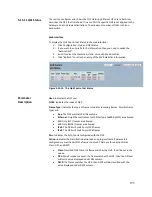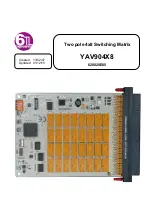
192
SMAC:
Displays the OUI field of source MAC address (e.g. first three octet (byte) of
MAC address).
DMAC:
Specifies the type of destination MAC addresses for incoming frame.
Possible values are:
1.
Any:
All types of destination MAC addresses are allowed.
2.
Unicast:
Only unicast MAC addresses are allowed.
3.
Multicast:
Only multicast MAC addresses are allowed.
4.
Broadcast:
Only broadcast MAC addresses are allowed.
5.
The default value is “Any”.
VID:
Indicates (VLAN ID), either a specific VID or range of VIDs. VID can be in the
range 1-4095 or “Any”.
PCP:
Priority Code Point: Valid value PCP are specific (0, 1, 2, 3, 4, 5, 6, 7) or range
(0-1, 2-3, 4-5, 6-7, 0-3, 4-7) or “Any”.
DEI:
Drop Eligible Indicator: Valid value of DEI can be any of values between 0, 1, or
“Any”.
Conflict:
Displays QCE status. Resources required to add a QCE may not available. In
that case, it shows the conflict status as “Yes”. Otherwise, it is always “No”. Please
note that conflicts can be resolved by releasing the resource required by the QCE
and pressing “Refresh” button.
Action:
Indicates the classification action taken on the ingress frame if the
parameters configured matched the frame's content. There are three action fields:
Class, DPL, and DSCP.
1.
Class:
Classified QoS Class; if a frame matches the QCE, it will be put in the
queue.
2.
DPL:
Drop Precedence Level; if a frame matches the QCE, then the DP level
will set to value displayed under DPL column.
3.
DSCP:
If a frame matches the QCE, then the DSCP will be classified with the
value displayed under DSCP column.
Modification Buttons:
You can modify each QCE (QoS Control Entry) in the table
using the following buttons:
: Inserts a new QCE before the current row.
: Edits the QCE.
: Moves the QCE up the list.
: Moves the QCE down the list.
: Deletes the QCE.
: The lowest plus sign adds a new entry at the bottom of the QCE listings.
Port Members:
Mark the checkbox button if you want to make any port a member
of the QCL entry. By default, all ports will be checked.
















































